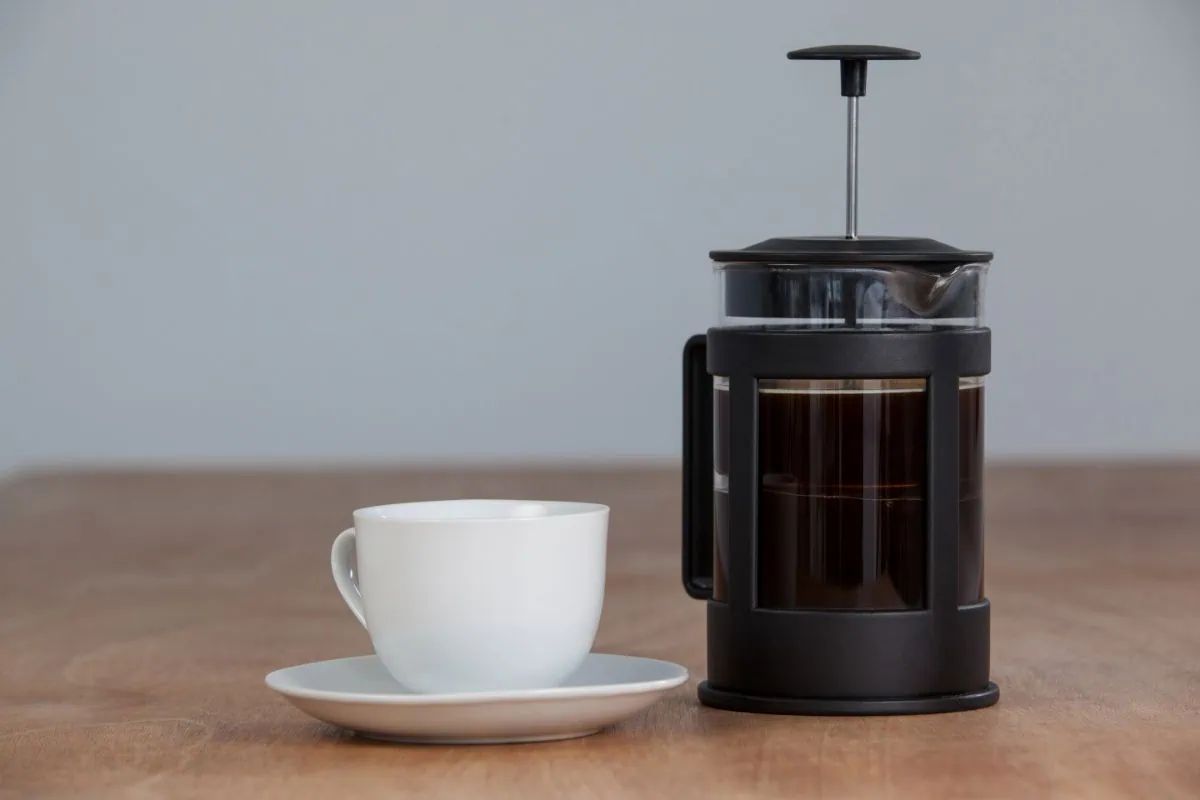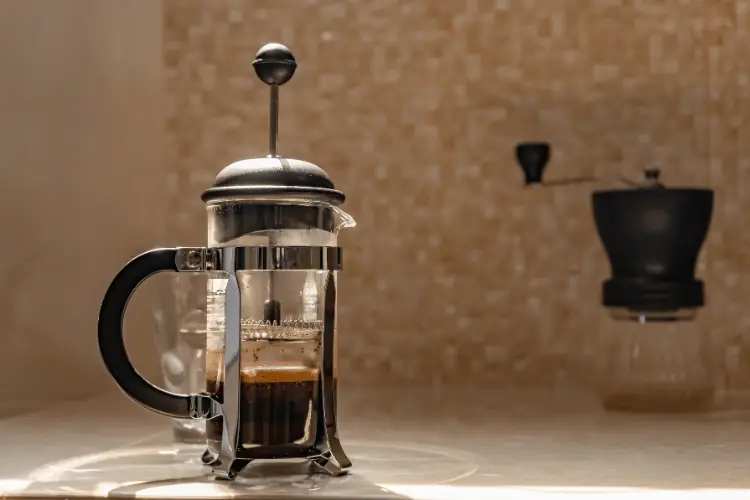With countless high-tech consumer-grade countertop machines on the market, it’s undeniable that we’re living in the golden age of home-brewed coffee.
Yet, even with all this technology available, you can’t beat a classic plunger coffee brewed and filtered in a quality French press.

As long as you buy some good beans or a good pre-grind, a French press will provide an incredibly rich, full-bodied brew the likes of which you’ve never tasted before.
They can be a little tricky to figure out when you first encounter them, though, so let’s break it down into an easy-to-follow, step-by-step process.
What You’ll Need
Before we begin, you’ll need to amass the following bits and bobs:
- A coffee bean grinder
- A French press
- A kettle or some other means of boiling water
- A teaspoon
- Your favorite mug
- Whole or coarse-ground coffee beans of your choosing
Making Plunger Coffee: A Step-By-Step Guide
Got all your gear in order? Fantastic; now we’re ready to brew some delicious coffee!
Step 1 — Heating Your Water
You don’t strictly have to heat your water before step 2, but if you’re strapped for time (who isn’t in the morning?), this is the most efficient approach, as you can grind your beans while your water is heating.
Step 2 — Grinding Your Beans
For the best possible results, you should grind your coffee beans fresh for each plunger brewing session. The flavor will be poppin’, the smell will send you to heaven, and the hands-on nature of grinding the beans yourself becomes quite ceremonious and enjoyable.
Pre-ground beans will of course do in a pinch, but more often than not, they’ll have a slightly stale flavor, even when expertly brewed in a French press.
If you do take the pre-ground route, be sure to pick up coarse-ground beans, as anything finer may bypass the filter — It’ll be sludge city!
Measure the weight of your ground beans. You should be aiming for a 1:12 coffee-to-water ratio, so you need to be quite precise from the get-go, keeping the maximum capacity of your French press in mind.
Step 3 — Preparing The French Press
A French press is composed of two main parts, the glass or steel carafe and the lid with the built-in plunger. To get the ball rolling on your first tasty plunger coffee, you first need to remove the plunger from the equation by opening the lid.
With just an empty carafe in front of you, you’re almost ready to go, but it’s good practice to give the base of the container a quick rinse with a splash of hot water.
Step 4 — Brewing The Coffee
Once you’re satisfied that your carafe is squeaky clean, discard the water, pour in your coffee grounds, then add just enough hot water to turn the grounds into a thick, concentrated liquid.
Side note: Bear in mind that boiling water will burn the grounds. The ideal temperature for brewing quality coffee is about 92 °C. You can achieve this temperature by waiting 30 seconds after the kettle has finished boiling before pouring it into the carafe. If using a pot and stove to heat your water, we’d recommend picking up a thermometer.
When the first drizzle of water has been poured, wait a moment or two, then add 100 ml of hot water per cup of coffee you plan on serving.
Give your coffee about three minutes to brew, or if you like a particularly strong coffee to shake the dreams loose in the morning, wait a further 1–2 minutes.

Step 5 — Filtering The Coffee
Pull the plunger so the filter is as close to the lid as it will possibly go, secure the lid on the carafe, hold it in place with one hand, then use the other to steadily force the filter down into the coffee.
Push it all the way to the bottom, thereby removing all particulate matter from the bulk of the liquid in the carafe.
Step 6 — Pouring Your Coffee
One of the most common mistakes newcomers to plunger coffee make is to leave their coffee in the French press once filtration has already occurred. If you want the best cup of coffee possible, you must pour out the entire carafe as soon as filtration is complete.
Although the filter isolates the particulate matter floating around in your coffee, it does not separate them from the liquid, meaning the longer you leave your coffee in the carafe, the longer your coffee is brewing, growing ever more bitter and strong.
That may well be to your tastes, but for the smoothest, richest flavor, full of natural sweetness, you need to pour straight away.
So, whether you’re pouring for yourself or for three people, it all needs to happen immediately. This is why we’d recommend having your mugs at the ready.
Step 7 — Milk Or Sugar?
This step comes entirely down to your discretion. If you prefer black coffee, you’re good to go, but if you prefer a milkier, sweeter brew, now’s the time to augment.
Step 8 — Enjoy!
Considering the simplicity of the equipment, plunger coffee is miraculously satisfying. It’s the kind of coffee that should be savored, every sip gently buffeting the cobwebs from your mind, body, and soul.
Take your time, read the paper, watch the news, stare vacantly out of the window… whatever your morning routine involves, it can be made a billion times better with a freshly pressed plunger coffee.
Final Thoughts
There you have it. Some people rule out the French press believing that it’s too much time and effort, but really, you’re looking at about 6 minutes per brew, which in the grand scheme of things is absolutely nothing, and the results you get are absolutely phenomenal!
Besides, there’s a tactility to making plunger coffee, a ceremoniousness that makes the manual nature of the brewing process an absolute delight.
Frequently Asked Questions
Why Are There Still Grounds In My Plunger Coffee After Filtration?
While you can pick up specialized manual grinders or choose coarse grains on an electric grinder, they’re not completely infallible tools.
Most of the grounds will be coarse, but others will inevitably be broken down into smaller pieces, some small enough to penetrate the tiny holes in the filter and return to your pouring coffee.
It doesn’t mean you did anything wrong; it’s just one of those unavoidable things.
Are French Presses Worth The Effort?
French presses are absolutely worth the effort. You can use fresh-ground beans, the coffee is silky smooth, and the flavors are robust. The brewing process is also a lot of fun if you ask us!







